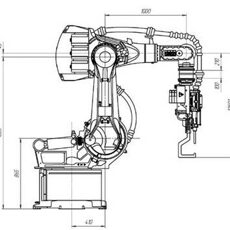Industrial Robots
Industrial robotics is a modern branch of production engaged in the development and manufacture of industrial robot manipulators and systems aimed at automating production processes and replacing manual labor with mechanical.
Industrial robots are software-controlled devices that carry out movement, movement and control within the framework of production processes. Their main purpose is to perform certain operations and move objects under the control of the operator or autonomously.
Experts distinguish three main types of industrial robots:
1. Automatic:
• Programmable robots operate on the basis of a predefined cyclic program that is stored in memory. These are the simplest and most affordable devices.
• Adaptive robots have built-in sensors and sensors that allow you to change the program depending on external conditions.
• Trained robots can adjust their program during the technological process, adapting to changes.
• Intelligent robots are the most modern devices equipped with elements of artificial intelligence, which allows them to analyze the environment and make appropriate decisions.
2. Biotechnical:
• Manipulators or command robots are controlled by an operator from afar.
• Copying robots repeat the actions of the operator.
• Semi-automatic robots, using a control system, coordinate and adjust the movement of their joints in accordance with the operator's commands.
3. Interactive:
• Automated robots work in automatic mode, alternating it with the work of the operator.
• Supervising robots perform a given cycle automatically, but switching between different stages is carried out by operator commands.
• Dialog robots interact with the operator in a special language, for example, by means of voice commands, while they function in automatic mode.
Industrial robots are also classified by load capacity:
• Light robots are capable of lifting up to 10 kg.
• Medium robots are capable of lifting from 11 to 200 kg.
• Heavy robots are capable of lifting from 200 kg to 1 ton.
• Super-heavy robots are capable of lifting more than 1 ton.
They can also vary in maneuverability:
• Stationary robots have a fixed position and do not move.
• Mobile robots are able to move around production sites.
And finally, industrial robots can be installed in various ways:
• Embedded robots are embedded in production equipment or production lines.
• Suspended robots are installed using a suspension system.
• Floor robots are placed on the floor and can move in a given area.
The choice of an industrial robot depends on the conditions of its operation and the tasks set by the manufacturer.
"Deltapro Automation" LLC will help you choose the right production model from leading European and Asian manufacturers, as well as to carry out commissioning and training of your personnel.

